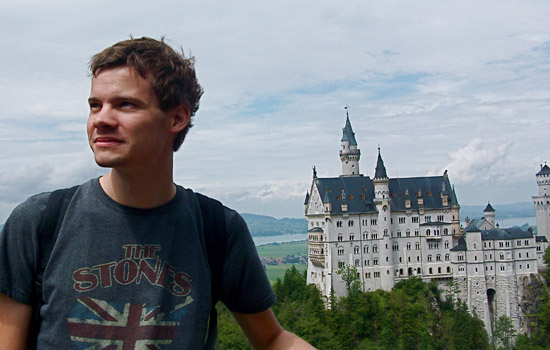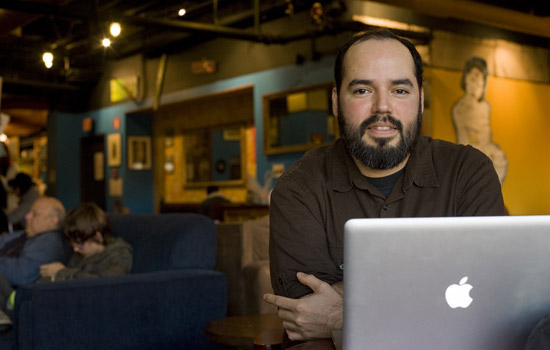Carving out a science career one post-doctoral fellowship at a time
Astrophysical sciences and technology graduates take next step
A. Sue Weisler
Astrophysical sciences and technology grad Rudy Montez is seeking a second post-doctoral assignment in the United States or in Europe.
Grant Tremblay ’11 (astrophysical sciences and technology, Ph.D.) and Rodolfo Montez Jr. ’11 (astrophysical sciences and technology, Ph.D.) think in terms of light years. It’s a natural habit: They’ve spent years studying astronomical phenomena observable only with sophisticated space telescopes like NASA’s Chandra X-ray Observatory and the Hubble Space Telescope, and the European Space Agency’s Herschel Space Observatory.
Their hard-won doctoral degrees give Tremblay and Montez the credentials they need to unlock the next door on their path to a career in science—the post-doctoral fellowship. RIT’s astrophysical sciences and technology doctoral degree program is supported by the Department of Physics, the Chester F. Carlson Center for Imaging Science and the School of Mathematical Sciences. Everyone involved is watching the first two graduates from the program enter the real world of science with all of its possibilities and pitfalls.
“As post-docs, Rudy and Grant will be making the transition to become fully fledged research scientists, gaining the skills and experience that will equip them to develop and maintain their own research programs,” says Andrew Robinson, professor of physics and director of the astrophysical sciences and technology graduate program at RIT. “Their dissertation work has made them experts in their specific topics. Now they will apply what they’ve learnt to identify and solve new problems and so make their contributions to our exploration of the universe.”
Tremblay won a post-doctoral fellowship with the European Southern Observatory. The astronomical organization—comprised of members of the European Union and Brazil, operates large ground-based observatories in the desert of Chile. The three-year fellowship places Tremblay at “the crossroads for astronomy in Europe” and in contact with leading scientists in his field.
Tremblay arrived in Munich on Aug. 1 with his “earthly possessions reduced to two bags,” a sketchy grasp of German and an optimistic attitude.
“I think you should always try to be a foreigner at some point in your life,” he says.
As a fellow at European Southern Observatory, Tremblay is expanding upon his thesis research on active galactic nuclei, or bright galaxies that emit enormous amounts of radiation. Jets of plasma spew copious amounts of energy from a centrally located black hole and illuminate the galaxies from within.
In addition to his own research, Tremblay will provide support for the organization’s Very Large Telescope and the future Atacama Large Millimeter/submillimeter Array.
When Tremblay’s plane landed in Germany, Montez was in Tenerife, Spain, following the International Astronomical Union Symposium “Planetary Nebulae: An Eye to the Future” on the Canary Islands in Puerto de la Cruz. Montez presented “Early Results from ChanPLaNS: Mystery of Hard X-ray Emitting CSPNe,” July 25–29.
Montez’s postdoctoral fellowship with his RIT thesis adviser, Joel Kastner, professor in the Center for Imaging Science, is supported by funding he helped win last year from the Chandra X-ray Observatory. Chandra awarded the team nearly a week of observing time—unusual by any standards—for 21 planetary nebulae, or dying stars. Montez is leading the RIT team of graduate and undergraduate students and coordinating the research of 24 collaborators around the globe. He represented the team in Spain for an update on the large observing project.
“We are using the Chandra X-ray Observatory to conduct the first systematic X-ray Survey of planetary nebulae in the solar neighborhood,” Montez says. “When complete, this survey will provide a suite of new X-ray diagnostics that will inform the study of late stellar evolution, binary star astrophysics and wind interactions.”
Montez is seeking a second post-doctoral assignment in the United States or in Europe, a game of musical chairs that Tremblay will rejoin at the end of his fellowship at the European Space Observatory. Typically, young astronomers must collect a couple fellowships before they can expect to land a permanent position at a university or other research institute, notes Tremblay, who has published 12 papers.
Young scientists must drive their own research, form collaborations, publish and present their work to their peers. Montez has published nine papers, with two more currently under review. He will write another five papers before wrapping up his post-doctoral fellowship at RIT.
Montez expects to learn about a promising opportunity before the end of the year. Not content to count proverbial chickens, he will resume the lengthy process of applying for the next round of available postdoctoral fellowships that the American Astronomical Society will post in September.
“After two post-docs you do what many astronomers do, you seek out tenure,” Tremblay says.
Scientific meetings are a useful place to meet collaborators, which potentially can lead to other research opportunities. Montez has earned an early reputation for discovering hard X-ray emissions in binary systems and is a sought after collaborator.
A paper Montez is writing with a Swedish colleague about X-ray emission from asymptotic giant branch stars—the phase of dying stars just before the planetary nebula phase—resulted from a scientific meeting last year. And the recent symposium in Spain has led to his latest research project with a colleague from Mexico to explore magnetic fields of white dwarfs and the central stars of planetary nebulae.
 Grant Tremblay with the Neuschwanstein Castle in the background, outside of Munich. He Tremblay won a post-doctoral fellowship with the European Southern Observatory.
Grant Tremblay with the Neuschwanstein Castle in the background, outside of Munich. He Tremblay won a post-doctoral fellowship with the European Southern Observatory. 











